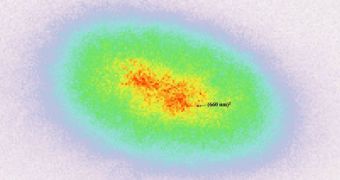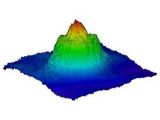Ultracold atomic gases are the standard in quantum physics observations, mostly because they can offer unprecedented insight into the effects that appear when transitions from one quantum state to the other take place. While these transitions are usually fun to look at, they are even more spectacular at the quantum level. Researchers at the University of Chicago have now for the first time ever observed directly the transition between phases of ultracold cesium gas, from normal to superfluid to Mott insulator, the National Science Foundation (NSF) reports.
“These are the first direct images of a complete physical system in situ, allowing us to unambiguously observe certain unique features of the Mott insulating state,” explains UC postdoctoral student Nathan Gemelke. The expert, working with a team of colleagues, managed to obtain one of the most peculiar images of such a transition, which reveals a many-layered, wedding cake-like structure. Details of the research are published in the latest issue of the journal Nature.
“The Mott insulator phenomenon was first observed in ultracold atomic gases in 2002, by the group of Ted Hänsch, at the Johannes Gutenberg-University in Mainz, Germany, and has been a subject of intense research ever since,” says paper co-author and UC assistant professor Cheng Chin. Mott insulators only form at very low temperatures, when materials that otherwise conduct electricity suddenly stop doing that, on account of bizarre electron interactions triggered by the cold. The UC team designed an artificial system that behaves precisely like a Mott insulator.
The system was constructed from ultra-cold cesium atoms, trapped in a lattice of laser beams. “In a Mott insulator, there is exactly one atom at every site, or two, or three, but never a mixture of, say, one here, two there, etc.,” Chin explains. “The superfluid and normal phases of the ultracold gas will react to small pressures by changing their volumes, and will react to small forces by flowing freely. In contrast, the Mott insulator phase has a constant density. Even when it's trapped, if you squeeze it gently, its volume will not change, which means it is incompressible. And if you apply a small force across it, particles do not flow through it, because it acts as an insulator,” Gemelke adds.
The team realized that it could take advantage of the differences between quantum phases, and used measurements of the trapped gas to create visual images of the transitions. “In two dimensions, the normal, superfluid and Mott insulating phases can be identified by spatially resolved in-situ imaging,” Gemelke reveals. “In three dimensional systems, the image integrates the density along the line-of-sight, so the measurements represent the combined properties of several phases.”
“The different layers of the cake are formed by Mott insulating domains of successively higher particle numbers, and their flatness results from their incompressibility. The edges as we go from one layer of the cake to the next are superfluid regions, where the density varies continuously. As the temperature is increased, the cake melts like a multi-tiered ice cream cake, and smears out the edges of the layers. By measuring its shape, we can infer the temperature-and unlike an ice cream cake, the result is within fifteen parts-per-billion of absolute zero,” he concludes.

 14 DAY TRIAL //
14 DAY TRIAL // 
